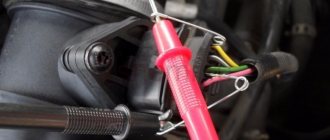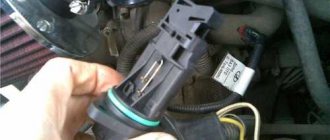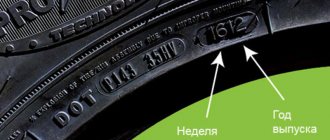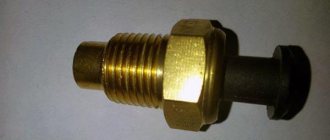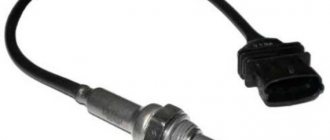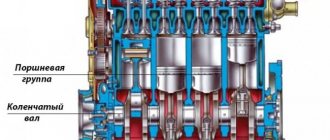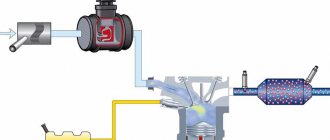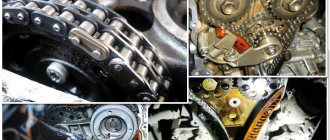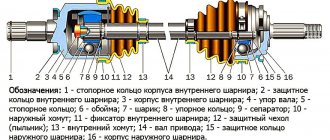Modern internal combustion engines, both gasoline and diesel, operate under the “guidance” of an electronic control unit (ECU). It controls all engine systems and, based on the data received, forms a fuel-air mixture. As you know, neither gasoline nor diesel fuel burns on its own. Vapors mixed with oxygen in the air ignite. To prevent the process from turning into an uncontrollable fire, it is necessary to accurately calculate the proportions of fuel and air. The stoichiometric, that is, ideal ratio, is 1 part of the mass of fuel and 14.7 parts of the mass of air.
Principle of operation
The sensor consists of platinum filaments (which is why it is not cheap), through which an electric current is passed, heating them. One thread is the control thread, air passes through the second, cooling it. The sensor produces a pulse-frequency signal, the frequency of which is directly proportional to the amount of air passing through the sensor. The controller records changes in the current passing through the second, cooled filament and calculates the amount of air entering the engine. Depending on the frequency of the signals, the controller sets the duration of operation of the fuel injectors, adjusting the ratio of air and fuel in the fuel mixture. The readings of the mass air flow sensor are the main parameter by which the controller sets fuel consumption and ignition timing. The operation of the flow meter affects not only the overall fuel consumption, mixture quality, engine dynamics, but also, indirectly, the engine life.
TEST SEQUENCE
HINT: Use a handheld diagnostic tool to read the fixed parameters. These parameters reflect the state of the engine at the time the malfunction was detected. When troubleshooting, fixed parameters allow you to determine whether the car was moving at the time of the malfunction or not, whether the engine was warmed up, what the air-fuel mixture was (lean or rich), etc.
| 1.TAKE HAND-HELD TEST READINGS (MASS AIRFLOW) |
Connect the handheld diagnostic tool to the DLC3.
Start the engine and turn on the handheld scan tool.
Select the following menu items: Powertrain / Engine and ECT / Data List / MAF.
Read the values displayed on the scan tool.
Result:
| Air mass flow (g/s) | Next step |
| 0,0 | A |
| Not less than 271.0 | B |
| Between 1.0 and 270.0 (*1) | C |
*1: The value should change when the throttle valve is opened or closed while the engine is running.
| B |
Go to step 6 C
CHECK FOR INTERMITTENT PROBLEMS
| A |
| 2.CHECK MASS AIRFLOW SENSOR (SUPPLY VOLTAGE) |
Disconnect the mass air flow (MAF) sensor connector B1.
Turn on the ignition (IG).
Measure the voltage between the harness-side connector pin and ground.
Rated voltage:
| Contacts for connecting a diagnostic tool | Specified conditions |
| +B (B1-3) - mass | 9-14 V |
Reconnect the mass air flow sensor connector.
| NG |
Go to step 5
| OK |
| 3.CHECK MASS AIRFLOW SENSOR (VG TERMINAL VOLTAGE) |
Check the output voltage.
Disconnect connector B1 of the MAF sensor.
Apply battery voltage to terminals +B and E2G.
Connect the scan tool positive (+) probe to terminal VG and the scan tool negative (-) probe to terminal E2G.
Rated voltage:
| Contacts for connecting a diagnostic tool | Specified conditions |
| VG (5) - E2G (4) | 0.2-4.9 V |
Reconnect the mass air flow sensor connector.
| NG |
REPLACE MASS AIRFLOW SENSOR
| OK |
| 4.CHECK HARNESS AND CONNECTOR (MASS AIRFLOW SENSOR - ECM) |
Disconnect connector B1 of the MAF sensor.
Disconnect ECM connector B32.
Nominal resistance (check for open):
| Contacts for connecting a diagnostic tool | Specified conditions |
| VG (B1-5) - VG (B32-118) | Less than 1 ohm |
| E2G (B1-4) - E2G (B32-116) |
Nominal resistance (check for short circuit):
| Contacts for connecting a diagnostic tool | Specified conditions |
| VG (B1-5) or VG (B32-118) – weight | 10 kOhm or more |
Reconnect the mass air flow sensor connector.
Connect the ECM connector.
| NG |
REPAIR OR REPLACE HARNESS OR CONNECTOR
| OK |
| REPLACE ECM |
| 5.CHECK HARNESS AND CONNECTOR (MASS AIRFLOW SENSOR - INTEGRATED RELAY) |
Disconnect connector B1 of the MAF sensor.
Remove the integrated relay from the No. 1 relay block in the engine compartment.
Nominal resistance (check for open):
| Contacts for connecting a diagnostic tool | Specified conditions |
| +B (B1-3) - 1A-4 | Less than 1 ohm |
Nominal resistance (check for short circuit):
| Contacts for connecting a diagnostic tool | Specified conditions |
| +B (B1-3) or 1A-4 - mass | 10 kOhm or more |
Reconnect the mass air flow sensor connector.
Reinstall the integrated relay.
| NG |
REPAIR OR REPLACE HARNESS OR CONNECTOR
| OK |
| CHECK ECM POWER CIRCUIT |
| 6.CHECK HARNESS AND CONNECTOR (SENSOR GROUND) |
Disconnect connector B1 of the MAF sensor.
Nominal resistance:
| Contacts for connecting a diagnostic tool | Specified conditions |
| E2G (B1-4) - mass | Less than 1 ohm |
Reconnect the mass air flow sensor connector.
| OK |
REPLACE MASS AIRFLOW SENSOR
| NG |
| 7.CHECK HARNESS AND CONNECTOR (MASS AIRFLOW SENSOR - ECM) |
Disconnect connector B1 of the MAF sensor.
Disconnect ECM connector B32.
Nominal resistance (check for open):
| Contacts for connecting a diagnostic tool | Specified conditions |
| VG (B1-5) - VG (B32-118) | Less than 1 ohm |
| E2G (B1-4) - E2G (B32-116) |
Nominal resistance (check for short circuit):
| Contacts for connecting a diagnostic tool | Specified conditions |
| VG (B1-5) or VG (B32-118) – weight | 10 kOhm or more |
Reconnect the mass air flow sensor connector.
How to comply with consumption standards
The dosage of the liquid component is easy to ensure. The pressure, the diameter of the gas line, and the throughput of the fuel injectors are known. By opening the injector valve for a certain time, the ECU controller can fill the combustion chamber of the cylinder with exactly as much gasoline as is required to form the mixture. How to measure the mass of incoming air?
To generate data on the amount of air, injection cars are equipped with a mass flow sensor. It converts information from physical (kg/hour) to electronic, in the form of varying voltage at the sensor output. There are even special calibration schedules for the engine ECU.
A certain mass of air passing through the mass air flow sensor corresponds to a clearly established voltage value, accurate to 1/1000 volts.
Having received additional information:
- air temperature;
- the presence of oxygen in it;
- engine temperature;
- data from lambda probes;
- speed from crankshaft sensor;
The electronic control unit mixes the optimal proportion of the fuel mixture in the combustion chambers of the cylinders.
Since the air sensor generates a continuous stream of data, the mixture composition is adjusted in real time, ensuring acceptable fuel consumption for the vehicle. In addition, based on this data, the ECU complies with exhaust gas toxicity standards in accordance with the Euro environmental standard for a particular vehicle.
Many fans of power plant tuning are wondering: is it possible to drive without a mass air flow sensor? There is a misconception that this device is intended solely for the environment, and turning it off will increase the power of the car. To get the correct answer to this question, let’s look at the mass air flow sensor device.
Features of the mechanism
Before answering the question whether it is possible to drive without a mass air flow sensor, it is necessary to understand the constituent features of the device. The device is located in the air intake duct, immediately behind the filter. The block from the channel network is responsible for connecting to the control unit. In some modern vehicles, a different connection technology is possible.
It would seem that the operation of the damper is simple. The gas pedal is pressed, opens, the required volume of air is drawn in, the damper closes and a smaller amount is admitted. But in practice things are different. When driving a vehicle, the driver constantly changes the performance by pressing the gas pedal, therefore the engine does not function equally. Whirls occur and air cannot enter in the same volume, making calculations difficult.
The mass air flow sensor differs in design. You can ride with anyone as long as it fits the car. Highlight:
- mechanical;
- ultrasonic;
- thermal-anemometric.
The latter are used only on domestic VAZ vehicles. There will be a penalty if you use other components.
The devices are multi-component, but there are no moving parts. This fact explains the stability of operation even in difficult weather conditions and a long service life. It is not possible to repair it; it is easier to purchase a new one. The sensitive element is a nickel mesh or platinum wire. The characteristics depend on the manufacturing company. A wire that transmits an electric charge is connected to a small structural part. The element heats up above the air temperature, can reach 100 degrees Celsius. For nickel units the maximum threshold is 75 degrees, and for platinum units - up to 100 degrees.
The equipment required for the machine consists of the following elements:
A constant pulse of electricity is required in order to cool the elements affected by the air flow. Direct determination of the air entry rate, that is, its volumetric characteristics, is determined by the degree of how the required current indicators change.
Old-style mechanisms determine this by frequency pulses transmitted to the control panel. Modern equipment models set the required indicators for heating elements and sensors for increasing or decreasing temperature. The element is placed on a special thin film, which is tightly mounted.
Principle of operation
- a device is visited at the center of the film that controls heating, its degree and characteristics;
- temperature sensors are connected to the main heating zone, that is, where average indicators are observed;
- two other thermal sensors are located on both sides of the film (one is hidden behind the film, and the second is located directly in the path of the air flow).
When the vehicle is in an inactive state, the sensor will not react in any way, since the temperature of all elements is the same. This is explained by the fact that the incoming flows cool the device, while the performance of the other two remains unchanged - they do not react without driver intervention. When the movement begins, a rapid passage of air into the equipment is observed, the sensors begin to work. It is from the volume of intake air and the degree of supply of electric current, which is required to compensate for adequate values, that the temperature difference is calculated. This characteristic determines how much consumable fuel is required and the fuel ratio.
What happens if you turn off the mass air flow sensor?
Let's start with the fact that when the flow meter is turned off, the engine goes into emergency operation mode. What could this lead to? Depending on the car model and, accordingly, the firmware, the engine will stop (as on Toyota), increase fuel consumption, or... nothing. Judging by numerous messages from auto forums, experimenters note increased agility after shutdown and the absence of failures in engine operation. No one has carried out careful measurements of changes in fuel consumption and engine life. Whether it is worth trying such manipulations on your car is up to the owner to decide.
Interchangeability
This issue is quite relevant, especially taking into account the cost of original products from the imported automobile industry. But it’s not so simple here, let’s give an example
In the first production models of the Gorky Automobile Plant, the injection Volgas were equipped with a BOSCH air flow sensor. Somewhat later, imported sensors and controllers replaced domestic products.
A – imported filament air flow sensor manufactured by Bosh (pbt-gf30) and its domestic analogues B – JSCB “Impuls” and C – APZ
Structurally, these products were practically no different with the exception of several design features, namely:
- The diameter of the wire used in a wirewound thermistor. Bosch products have a diameter of 0.07 mm, and domestic products have a diameter of 0.10 mm.
- The method of fastening the wire differs in the type of welding. For imported sensors this is resistance welding, for domestic products it is laser welding.
- Shape of a thread thermistor. Bosh has a U-shaped geometry, APZ produces devices with a V-shaped thread, and products from JSC Impulse are distinguished by the square shape of the thread suspension.
All the sensors given as an example were interchangeable until the Gorky Automobile Plant switched to film analogues. The reasons for the transition were described above.
Film air flow sensor Siemens for GAZ 31105It makes no sense to give a domestic analogue to the sensor shown in the figure, since outwardly it is practically no different.
It should be noted that when switching from filament devices to film devices, most likely, it will be necessary to change the entire system, namely: the sensor itself, the connecting wire from it to the ECU, and, in fact, the controller itself. In some cases, the control can be adapted (reflashed) to work with another sensor. This problem is due to the fact that most filament flowmeters send analog signals, while film flowmeters send digital signals.
Symptoms of a problem
A malfunction of the mass air flow sensor can be indirectly judged by the following symptoms:
- The CHEK ENGINE lamp comes on;
- The car accelerates slowly (stumbles);
- Unstable engine operation at idle;
- Engine bad;
- Increased fuel consumption;
- The engine stalls while driving when changing gears.
Dirty DMRV (side view)
The symptoms described above can be caused by other reasons, so it is better to accurately check the mass air flow sensor at a service station using specialized equipment. If you don’t have time, don’t want to, or don’t feel like spending money, you can check the performance of the mass air flow sensor yourself with high, but not 100% reliability.
Dirty DMRV (top view)
What does a faulty air flow sensor cause?
Operating an engine with an inoperative/faulty flow meter causes detonation of the fuel mixture in the combustion chamber. This affects the operation of the crank mechanism (crank mechanism) and destroys the piston surface, which can cause a “wedge” in the engine.
What indications should a working mass air flow sensor give?
The voltage of the analog-to-digital converter (ADC) of the flow meter when the engine is not running should be 0.996 V. Indicators of 1.016 and 1.025 V are acceptable, but if they reach more than 1.035 volts, it means that the sensing element of the mass air flow sensor is clogged.
To accurately determine the degree of deviation of the operating flow meter values from normal values, it is necessary to evaluate the engine operation at different speeds.
For example, for an injection 1.5-liter VAZ 2111 engine, if it is in good condition, at idle (860–920 rpm) the correct readings are 9.5–10 kg/hour, and at 2 thousand rpm - 19 –21 kg/hour. If the flow meter at 2 thousand rpm shows about 17–18 kg, then the car will drive stably. If the values are from 22 to 24 kg/hour, then the vehicle will move steadily, but the fuel consumption per 100 km will be approximately 10–11 liters. In addition, the car will have difficulty starting in cold weather due to fuel overflow when the engine warms up.
Video “Checking the mass air flow sensor using a multimeter”
This video from the “Simple Opinion” channel demonstrates how to check the mass air flow sensor with a multimeter.
Help me figure out if the DMRV malfunctions, immediately change the DMRV or clean it. And how to check the DMRV. and how did your car behave with a faulty air sensor and after replacing it?
Comments 11
But when I turn off the mass air flow sensor, the car stalls, is that how it should be?
Soak it in gasoline overnight. It helped me when carb cleaner didn’t help!
I turned off the DMRV today, nothing has changed
That means it’s not a matter of the mass air flow sensor!
It’s just that the diagnostics already show that the DMRV has been screwed up and the control unit is blocked; it’s already in emergency mode. I don’t have a check on my car. I have an EPS (control of engine electronics). I think I’ll probably buy a new one.
YOU CAN check! turn it off and that's it! The car will start working in an “emergency” state, the “check” will light up! and try to ride! Good luck!
The spark plugs are blown, when you give it gas, there is black smoke at rpm. As they say, the consumption increases
first, of course, try to clean it, it’s cheaper than changing it right away, if that doesn’t help, then of course replace it. Symptoms of a dead sensor can be either separately, but more often all together - it becomes dull when accelerating, eats gasoline in buckets (for 1.6 liters 12-13 probably), the smell of gasoline from the exhaust pipe when the engine is running, black carbon deposits on the spark plugs. In general, if the computer says that there is a weak signal from the DMRV, then it is half-dead, but it can be brought back to life) regarding cleaning - I would not recommend cleaning it with carbkiner, it is a very active mixture. although people cleaned it, it seemed without consequences, at least at first)) (certain types of air flow sensors, tape ones definitely cannot be cleaned) I cleaned mine like this - I warmed up a glass of alcohol in the microwave, lowered the sensor there to let it dry (this three or four times), then I very carefully cleaned those very sensitive elements with a pen and alcohol. I took photos before and after the event - the difference is noticeable, and this difference was visible only during macro photography and when viewing the photo on a 16x zoom)) after cleaning, the smallest wire on the sensitive elements became visible.
Messages 12
1 Topic from Vital 2111 2016-02-12 19:18:47
- Vitalya 2111
- New member
- Inactive
- Registration: 2016-02-08
- Messages: 6 Thanks : 1
- Auto: 2111
Topic: problems with engine speed and starting, Is it possible to drive without a mass air flow sensor?
Hi all . I encountered this problem: the engine starts, then the speed drops and the engine stalls; when you press the gas, it stalls immediately. Replacing the IAC and TPS, cleaning the DZ did not give any results, all the symptoms are the same. I decided to turn off the mass air flow sensor, it started from half a turn, the speed floats, drops to 500, but it doesn’t stall and responds normally to the gas. Is it possible to drive without a mass air flow sensor?
2 Reply from sergo9531 2016-02-12 19:25:57
- sergo9531
- Local
- Inactive
- From: Domodedovo
- Registration: 2014-01-12
- Messages: 578 Thanks : 208
- Auto: 21114
Re: problems with engine speed and starting, Is it possible to drive without a mass air flow sensor?
Vitalya 2111 , it’s possible, but the consumption will increase. This infection is expensive, try to clean it. If there are traces of oil in the air duct to the engine, you need to repair the crankcase ventilation, and only then install a mass air flow sensor. otherwise it will fail quickly.
3 Reply from Alevtina.Trofimova 2016-02-12 19:26:02
- Alevtina.Trofimova
- Experienced
- Inactive
- From: Selty, UR
- Registration: 2014-08-04
- Messages: 181 Thanks : 65
- Car: VAZ 21103
Re: problems with engine speed and starting, Is it possible to drive without a mass air flow sensor?
Consumption will increase significantly, and when switching to neutral it will stall.
Is it allowed to travel?
You can drive without a mass air flow sensor - yes, but you should carefully assess the situation. When devices fail, the driver does not always have a spare one with him in his emergency kit. Also, sensors for some types of cars are extremely difficult to find, especially when it comes to brands of foreign cars.
In the event of a planned or emergency shutdown of the device, the vehicle operates in emergency mode. Only the throttle valve is responsible for preparing the air-fuel mixture. The state of affairs cannot be called correct, since it provides ideal performance indicators, quickly breaks down and leads to breakdown of the constitutive parts of the mechanism. What will happen if you drive without a mass air flow sensor for a long time, it is clear that the car will become unusable.
When operating in emergency mode, only the damper determines fuel consumption. There is high fuel consumption. There will be no fuel savings, which is extremely unprofitable in Russian realities. The crankshaft rotation speed will be at least half a thousand revolutions per minute. There are no gradations.
You can determine whether the sensor needs to be replaced yourself. To do this, the device is turned off and only the throttle valve reads the readings. If, in the absence of equipment, the vehicle moves quickly, then it is faulty and requires replacement.
Is it possible to drive without a mass air flow sensor, what problems will arise?
The question of whether it is possible to drive without a mass air flow sensor is of concern to many car enthusiasts.
The fact is that in modern cars special electronic devices are responsible for equipping the working mixture. The technical parameters of the mixture depend on the ratio in which fuel and air will be mixed. Depending on how much air has passed through the damper, the electronics understand how much fuel should be supplied to the car. In this case, the structural part that is responsible for determining the air flow through the throttle valve is the mass fuel flow sensor. Consequently, the mass air flow sensor is an important part of the mechanism, which indirectly determines the quality of the working mixture.
Diagnostics of mass air flow sensor
Difficulties in self-diagnosis of a flow meter are caused by the fact that it is a capricious device. Taking readings at the number of revolutions specified in the manual often does not give results. The readings are normal, but the sensor is faulty. Here are several ways to diagnose the performance of the sensor:
- The easiest way is to replace the mass air flow sensor with a similar one and evaluate the result.
- Check without replacement. Disconnect the flow meter. Unplug the sensor connector and start the engine. When the DMVR is disabled, the controller operates in emergency mode. The amount of fuel for the mixture is determined only by the throttle position. At the same time, the engine keeps speed above 1500 rpm. If the car becomes “faster” during a test drive, then most likely the sensor is faulty
- Visual inspection of the mass air flow sensor. Remove the corrugated air intake tube. First, carefully inspect the corrugation. The sensor may be working properly, but the reason for its unstable operation is cracks in the corrugated hose. If the surface is intact, continue the inspection. The elements (platinum threads) and the inner surface of the corrugation must be dry, without traces of oil and dirt. The most likely cause of the malfunction is contamination of the flow meter elements
. - Checking the mass air flow sensor with a multimeter. The method is applicable for Bosh mass air flow sensor with catalog numbers 0 280 218 004, 0 280 218 037, 0 280 218 116. We switch the tester to measure DC voltage, with a measurement limit of 2 Volts.
DMRV contact diagram:
MAF contact diagram
Location from closest to the windshield in order: 1. sensor signal input 2. MAF supply voltage output 3. grounding (ground). 4. output to the main relay. The color of the wires may vary, but the pin locations are always the same. Turn on the ignition without starting the engine. We connect the red probe of the multimeter through the rubber seals of the connector to the first contact (usually the yellow wire), and the black probe to the third to ground (usually the green wire). We look at the multimeter readings. A new sensor typically reads between 0.996 and 1.01 Volts. Over time, tension usually increases. A higher value corresponds to more wear on the sensor. 1.01…1.02 – sensor is working. 1.02…1.03 – the condition is not the best, but working 1.03…1.04 – the resource is at its limit. 1.04...1.05 - agony 1.05...and more - definitely, it's time to change.
All of the home diagnostic methods described above do not provide a 100% guarantee of the reliability of the result. A reliable diagnosis can only be made using special equipment.
FakeHeader
Comments 15
Still, the problem turned out to be him. I THINK nothing will be too bad, you can try bathing it in a solvent. I dipped it a couple of years ago so that it covered the sensor, held it for half an hour, let it dry, and since then I’ve been driving
Should I take it apart or do it just like that? And what solvent?
That’s right, if I’m not mistaken, I bathed in 646, first you can drip some solvent onto the plastic to make sure it doesn’t spoil it, although it won’t get any worse
I’m just afraid that if something happens, I won’t buy thread anymore. You'll have to switch to film and reflash. By the way, this morning the engine slammed, bless you, it barely started after that. We urgently need to change the current injector, but I don’t know how to detect it.
Well, the most correct option would be to remove all the injectors and check, but you can first look at the spark plugs, it seems to me that one will have to be different from the rest
Check for a hundred?
I’m just afraid that if something happens, I won’t buy thread anymore. You'll have to switch to film and reflash. By the way, this morning the engine slammed, bless you, it barely started after that. We urgently need to change the current injector, but I don’t know how to detect it.
Once upon a time, on a spot, a hundred sticks to the nozzle, the other end to the ear. It should click, but this is only to check the operation, and how it works, you need to remove the ramp.
The main signs of a malfunction of the mass air flow sensor are loss of engine power, difficult starting, “floating” engine speed. To find out the exact cause of the flow meter failure, you need to visually inspect the device and then test it with a scanner (via Openidag), a voltmeter or a motor tester.
Replacing the air flow sensor
To replace the sensor with your own hands, you need to prepare a shaped screwdriver and a “10” key.
The replacement procedure consists of the following steps:
- First you need to turn off the ignition and open the hood.
- Then you need to disconnect the negative terminal on the battery.
- At the next stage, you need to loosen the clamp with which the corrugation is attached to the mass air flow sensor.
- Next, remove the corrugation from the pipe.
- Then you need to bend the comb and disconnect the sensor connector.
Disconnecting the sensor connector
Then, using a key set to “10”, you need to unscrew the sensor mounting bolts to the air filter housing. Now you can remove the mass air flow sensor. Installing the sensor yourself is done in the reverse order.
Thus, if the car stalls and has all the signs of a breakdown of the mass air flow sensor, then before you start repairing it, you should check the level of its signal, it should not be low, perform a full diagnosis of the car and repair all faulty components and parts.
It is important to undergo regular vehicle inspections and perform timely maintenance, then the parts and components will last longer.
Do-it-yourself prevention and repair of mass flow sensors
The service life of the mass air flow sensor can be extended by timely replacement of the air filter and monitoring the condition of the piston rings and seals. Their wear causes excessive saturation of crankcase gases with oil. An oil film getting on the sensitive elements of the sensor kills it. On a sensor that is still alive, lost readings can be restored by the “Max air flow sensor corrector” program. With its help, you can quickly change the mass air flow sensor calibrations in the firmware. The program is easy to find and download without problems on the Internet. The luftmassensensor reiniger mass air flow sensor cleaner can help revive a non-functioning sensor . To do this you need:
- Remove the sensor from the engine as described above.
- Spray the product thoroughly and generously onto the sensitive element.
- Wait until any remaining dirt has drained away.
- Dry the sensor well before installation. For prevention, the procedure can be repeated before each air filter replacement.
MAF Toyota 22204-22010
If cleaning does not produce results, the faulty sensor must be replaced. The cost of a mass air flow sensor starts from 2000 rubles, and for imported models it is usually significantly higher, for example the price of a Toyota 22204-22010 sensor is about 3000 rubles. If the sensor is expensive, do not rush to buy a new one. Often products of the same marking are installed on different brands of cars, but the price as spare parts is different. This story is often observed with Bosh mass air flow sensor. The company supplies the same sensors for VAZ and for many imported models. You need to disassemble the sensor, write down the markings of the most sensitive element, it is quite possible that it can be replaced with a VAZ one.
